I think we have enough failed-disguise posts now to consider starting a new category, or at least a sub-category of The Criminal Mind. This does not quite rise to the level of What Not to Use as a Disguise #1 (tree branches) and #2 (duct tape), but it makes the list.
Robert Lavery was convicted last week of robbing the New Cumberland (Pennsylvania) Federal Credit Union in 2006, along with compadre Robert Miller. Robert L. robbed the bank while Robert M. waited in the getaway car. Unfortunately for the Roberts, each of them was distinctive in a way that made them fairly easy to identify.
For Lavery, this was because he chose drywall compound as a disguise, apparently smearing it all over his face. According to the article, this was a problem because when police found the two they also found clothing with drywall compound smeared on it, and more drywall compound in the passenger side of the car.
It might also have been a problem because it would seem to me that this "disguise" wouldn't obscure your facial features, just turn them a different color, but the article didn't mention this issue. I suppose it's possible that Lavery used several inches of the stuff on his face, or encased his head in a block of it. That would have solved the identity problem but made it pretty difficult to carry out the robbery, so it seems unlikely.
If Lavery could not be identified, and the only evidence was the presence of drywall compound in the car, that would have been circumstantial evidence of guilt but not damning. They might have only been guilty of home improvement. But Miller was also identified by witnesses who were familiar with his car, and in particular the NASCAR vanity license plate on the front, which Miller had failed to remove. That led police to Miller, who confessed.
Link: AP via FindLaw.com
